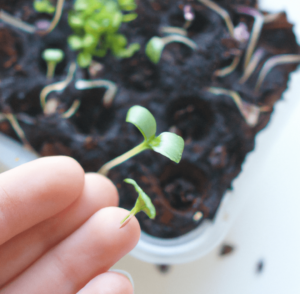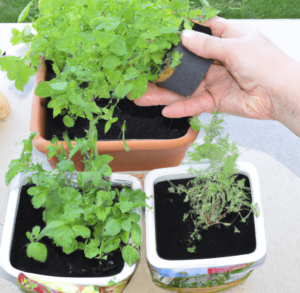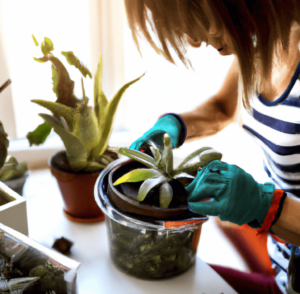After learning how to water your garden efficiently, you may also want to dive into how to fertilize your garden properly to keep the space healthy. By fertilizing your garden, you can make sure that the soil has an adequate quantity of nutrients, which will help your plants grow healthily, produce more, and be in better overall condition.
Understanding Your Garden’s Fertilizer Needs
The sort of plants and grass you have, as well as the number of nutrients in your soil, all affect how much fertilizer your garden needs. Understanding your plants’ individual fertilizer needs will help you make sure they get the proper amount of nutrients to promote their growth. In gardening, too much fertilizer can be just as destructive as not enough, so it’s crucial to apply fertilizer according to suggested limits. The objective is to give your lawn and plants the nutrients they require for healthy growth without harming them by applying too much fertilizer.

Factors That Affect Fertilizer Needs
As you learn how to fertilize your garden properly, there are factors you need to take into consideration like:
- Kind of Soil: The type of soil in which plants are grown has a significant impact on how much fertilizer is required. For instance, thick clay soils tend to hold onto nutrients longer than sandy soils, which can result in nutrients draining away quickly. As a result, different soil types may call for varied kinds and quantities of fertilizer.
- Climate: A plant’s need for fertilizer can be affected by the climate in which it is cultivated. For instance, plants may need more frequent watering in hot, dry conditions, which may speed up the rate at which nutrients are lost from the soil. On the other side, plants may develop more slowly in colder climates and need fertilizing less frequently.
- Plant Type: Varying plant types require different amounts of fertilizer. For instance, more nitrogen, phosphorus, and potassium may be needed by blooming plants to encourage blossom growth, whereas more iron and other micronutrients may be needed by foliage plants to maintain healthy leaves. It’s critical to select the proper fertilizer for the type of plant being grown.
- Grass: The type of lawn that is being produced can affect how much fertilizer is required. For instance, warm-season grasses like Bermuda grass may need more nitrogen in the summer than cool-season grasses like Kentucky bluegrass do in the spring and fall. It is crucial to select the proper fertilizer for the type of grass being cultivated as well as the appropriate quantity.
How to Determine What Type of Fertilizer to Use and How Often to Apply It
Garden upkeep includes fertilizing since it supplies vital nutrients like nitrogen, potassium, and other minerals to support plant development and health. However, it can be hard to know how to fertilize your garden properly if you don’t know how to use it. You’ll need to know the following:
- Soil Testing: Testing your soil is the first step in choosing the best sort of fertilizer to use. You can identify which nutrients your plants require and in what amounts by doing a soil test to evaluate the pH level and nutrient levels in your soil. A professional laboratory or a home testing kit can conduct a soil test.
- Plant requirements: The sort of fertilizer you should use depends depend on the plants you are growing in your garden. The sort of fertilizer you use should be tailored to the particular plants you are cultivating because various plants have varying nutrient needs. For instance, plants that produce flowers may need more phosphorus and potassium, whereas plants that produce leaves may need more iron and other micronutrients.
- Labels for fertilizers: Labels for fertilizers will list the quantity of nitrogen, potassium, and other nutrients that the product contains. To meet the unique requirements of your plants, it’s critical to select a fertilizer with the proper mix of nutrients.
- Frequency of Application: Several elements, such as the sort of plants you are growing, the type of soil they are growing in, and the environment, may affect how often fertilizer is applied. During the growing season, it is generally advised to fertilize your garden every 4-6 weeks. Nevertheless, depending on the particular requirements of your plants and soil, this might need to be changed.
These are important in determining how to fertilize your garden properly.
Choosing the Right Fertilizer
A garden needs the correct fertilizer in order to be healthy and successful. The necessary building blocks for plant growth and health can be supplied by a fertilizer that is rich in nitrogen, potassium, and other crucial nutrients. Before learning how to fertilize your garden properly, you need to have the right kind of fertilizer.
Types of Fertilizers
Learning how to fertilize your garden efficiently? There are different types of fertilizers available, and each has certain advantages and disadvantages:
- Organic vs. Synthetic Fertilizers: Organic fertilizers are produced using organic materials like compost, animal manure, and other natural, renewable sources. Contrarily, synthetic fertilizers are produced chemically and include inorganic nutrients. Both kinds of fertilizers can give plants the nutrients they need, but organic fertilizers may release the minerals more gradually and so offer a longer-lasting source of nutrients.
- Granular vs liquid fertilizers: granular fertilizers are distributed over the soil and then watered in. On the other hand, liquid fertilizers are applied straight to the soil or foliage after being diluted with water. Although liquid fertilizers can be taken by plants more quickly, granular fertilizers are often easier to store and apply.
- Slow-Release vs. Water-Soluble Fertilizers: Water-soluble fertilizers can leach out of the soil more quickly yet are promptly absorbed by plants. On the other hand, slow-release fertilizers release their nutrients more gradually over time, offering a more constant source of nutrients.
Think about these options and choose the one best suited to your needs.
How to Choose the Right Fertilizer for Your Garden
Yes, you can learn how to fertilize your garden properly and control pests in the garden naturally for your outdoor space to thrive but you need to choose the right fertilizer first based on:
- Crop Requirements: Because different plants have varied nutrient needs, it’s critical to select a fertilizer that is specially formulated for the crops you are growing. For instance, fruits normally need more potassium whereas veggies typically need more nitrogen.
- Type of Soil: The type of soil your plants are growing in can have an impact on the fertilizer you select. For instance, soils with a lot of organic content could need less fertilizer than stony or sandy soils. The nutrients your soil needs can be determined with the aid of a soil test.
- Nutrient Analysis: You can find out which elements are included in a specific fertilizer by consulting the nutrient analysis on the fertilizer label. You can choose a fertilizer using this information to ensure it contains the precise nutrients your plants need.
- Form of Fertilizer: There are many different types of fertilizers, including granular, liquid, and slow-release.
Selecting the proper fertilizer is critical to the health and development of your plants.
Fertilizing Techniques
Giving plants the nutrients they need to grow and develop is a crucial part of plant maintenance and how to fertilize your garden properly. Top dressing, side dressing, and root-feeding are a few of the fertilization methods. The method you select will depend on the kind of plants you’re growing, the kind of fertilizer you’re using, and additional elements like the soil type. For optimum plant health, it’s critical to pick a fertilizer that offers the proper ratio of nutrients like nitrogen, potassium, and phosphorus.
Best Times of Year to Fertilize
As you learn how to fertilize your garden efficiently, you need to do so at the best time:
- Spring: As your plants are just beginning to grow and require a boost of nutrients, spring is a crucial time to fertilize them. Vegetable gardens are a good example of this since you want to make sure your crops have access to the correct nutrients so they can develop into robust, healthy plants.
- Summer: It’s crucial to keep fertilizing your plants throughout the summer. They will be able to grow and develop as a result, particularly during the summer heat when they require more energy.
- Fall: As fall draws near, your plants’ development will begin to slow down. Your plants will receive a burst of vitality for the spring if you fertilize in the fall to help them get ready for the winter.
- Winter: Fertilizing plants is not necessary because they are dormant during the winter. However, you might need to fertilize your evergreen plants all winter long if they don’t hibernate.
How to Apply Fertilizer to Different Types of Plants
There are different requirements for plants which you’ll learn below. To know exactly how to fertilize your garden properly, think about the plants:
- Bulb: Fall fertilization is beneficial for bulb plants like tulips and daffodils. They are starting to conserve energy for the upcoming spring at this time. After planting, the soil can be fertilized with a general-purpose fertilizer.
- Shrubs: Both spring and fall are good times to fertilize shrubs like hydrangeas and roses. You can fertilize the soil at the shrub’s base using a balanced fertilizer, like a 10-10-10.
- Trees: Spring and early summer fertilizers are beneficial for trees. The kind of fertilizer you select will depend on the kind of tree you have, however, you can add a balanced fertilizer to the soil at the tree’s base.
- Vegetable Gardens: Regular fertilization is necessary for vegetable gardens, particularly throughout the growing season. You can fertilize the soil surrounding each plant using a balanced fertilizer, like a 10-10-10. Throughout the growing season, you can side-dress with compost or other organic matter.
Gardeners should be aware of the unique requirements of each kind of plant and modify their fertilizing practices accordingly.
Tips for Conserving Fertilizer and Avoiding Over Fertilizing
Here are some suggestions for fertilizer conservation and preventing over-fertilization:
- Has your soil been tested prior to learning how to fertilize your garden properly? This will inform you of the nutrients that are already in your soil and those that your plants require. This will help you use your fertilizer more effectively and prevent you from overfertilizing.
- Be sure to correctly apply the fertilizer according to the directions on the container. Your plants’ roots may become burned if you fertilize them excessively, which will stunt or kill them.
- Use the appropriate amount of fertilizer for your plants. Overuse of fertilizer can cause environmental pollution, excessive growth, and groundwater contamination.
- Timing is essential, so fertilize each species of plant at the appropriate time. For instance, whereas some plants require fertilizer in the spring, others do so in the fall.
- Think about employing organic fertilizers like bone meal, compost, and animal dung. Although organic fertilizers take longer to work, they give your plants a longer-lasting source of nutrients.
- Use crop rotation, which entails growing various crops in various garden locations each year. This helps to preserve fertilizer and stop the soil from being depleted.

Maintenance and Monitoring
Fertilizing is an important aspect of garden maintenance and plays a crucial role in providing plants with the necessary nutrients for growth. The right type and amount of fertilizer can make a significant difference in the health and appearance of your garden. When choosing a fertilizer, it is important to consider the type of plants you have and their specific nutrient requirements. For example, nitrogen is an essential nutrient for plant growth, but too much nitrogen can harm plants. To fertilize your garden properly, you should also consider the type of soil you have, as this affects how well the fertilizer is absorbed by the plants. Monitoring your plants regularly will also help you determine if they are receiving enough nutrients, or if you need to adjust your fertilization methods.
How to Monitor Your Garden’s Fertilizer Needs and Adjust Accordingly
To keep track of and adjust your garden’s fertilizer requirements:
- Soil testing: Regular soil testing is a crucial first step in determining the amount of fertilizer your garden needs. A soil test will notify you of the nutrients present in your soil and assist you in choosing the right fertilizers for your plants.
- Observation: Observe your plants’ development and general health on a regular basis. You may need to modify your fertilization schedule if they are growing too slowly, turning yellow, or displaying other symptoms of nutrient deficiencies.
- Labels on fertilizers: Read and abide by the directions, including suggested application times and rates, on the fertilizer label.
- Trying and Fail: Keep track of how various fertilizers and application rates affect your plants, and adjust as necessary. This will assist you in selecting the ideal fertilizer and application rate to maintain the health and growth of your plants.
- Watering: Ensure that you are providing your plants with the proper amount of water. Fertilizers can be washed away by overwatering, yet plants can absorb fertilizer less effective when they are underwatered.
- Crops: When modifying fertilizer, consider the unique requirements of various crops. Some crops might need different kinds of fertilizer, while others might need more or less fertilizer overall.
How to Maintain Your Fertilizer Tools and Storage
Sure, you know how to fertilize your garden properly but you need to make sure to take care of your tools and store them away:
- Clean and maintain your fertilizer spreaders, sprayers, and measurement cups on a regular basis. This will guarantee that they are functional and available for use when you need them.
- Keep fertilizer products cold and dry, away from moisture and direct sunlight. Be cautious to store the containers far from food, feed, and seed, and to keep them well sealed.
- If required, cover your eyes and wear gloves when handling fertilizer. Avoid breathing in dust or fumes and heed all safety directions and cautions on the product label.
- Get rid of fertilizer goods that are no longer needed or that have expired in accordance with local laws. Don’t dispose of leftover fertilizer in the garbage or down the drain because it might contaminate the environment and water sources.
- If there is a spill, clean it up very away, and dispose of any contaminated soil or absorbent material correctly.
Bottom Line: How to Fertilize Your Garden Properly
In this article on how to fertilize your garden properly, we’ve covered the key elements that affect your garden’s fertilizer requirements, including soil type, climate, and plant species, as well as the measures you can take to choose the best fertilizer for your plants and how frequently to apply it. We also talked about the various kinds of fertilizers, including liquid and granular, organic and synthetic, and how to pick the best one for your garden.
You can make sure that your garden gets the proper amount of fertilizer and nutrients, leading to healthy, productive plants, by paying attention to these suggestions and using the available resources.
How to Fertilize Your Garden Properly FAQs
What does it mean to learn how to fertilize your garden properly?
Adding nutrients to the soil to encourage healthy plant development is the practice called fertilizing. It is significant because it provides plants with the nutrients they need, particularly nitrogen, to grow healthily. By fertilizing your garden, you can make sure the soil has enough nutrients for your plants’ growth, increased production, and general health.
What elements influence a garden’s fertilizer requirements?
A garden’s fertilizer requirements might vary depending on the type of plants, the number of nutrients in the soil, the type of soil, the climate, and the type of grass. Making ensuring your plants receive the appropriate amount of nutrients will be easier if you are aware of these factors.
How does the need for fertilizer depend on the climate?
For instance, in hot, dry weather, plants would require more frequent watering, which could hasten the rate at which nutrients are lost from the soil. On the other side, plants may grow more slowly and require less fertilizer in colder climates.
How does a plant’s species affect its demand for fertilizer?
The requirements for fertilizer vary depending on the type of plant. For instance, more nitrogen, phosphorus, and potassium may be needed by flowering plants to promote blossom growth, whereas more iron and other micronutrients may be required by foliage plants to maintain healthy leaves.
How does the type of grass influence the amount of fertilizer required?
The amount of fertilizer needed can vary depending on the type of lawn being produced. For instance, cool-season grasses like Kentucky bluegrass may require more nitrogen in the spring and fall than warm-season grasses like Bermuda grass do in the summer.
How do you choose the right fertilizer to use and how frequently should you apply it?
Choosing the right fertilizer and how frequently to apply it requires doing soil tests, knowing the needs of the plants being cultivated, reading fertilizer labels, and taking into account a number of variables, including the soil type, climate, and type of plant.
Why is soil testing necessary and what does it mean?
A soil test determines which nutrients your plants require and in what amounts by measuring the pH level and nutrient levels in the soil. This is significant because it aids in your decision regarding the appropriate fertilizer to apply.
How can I avoid overfertilizing and conserving fertilizer?
Overfertilizing can harm plants and contaminate the environment so test your soil to find out what nutrients are already there and what your plants actually need, apply the fertilizer according to the directions on the container.
Also, think about using organic fertilizers and rotate your crops to protect your fertilizer and retain the health of your soil.







